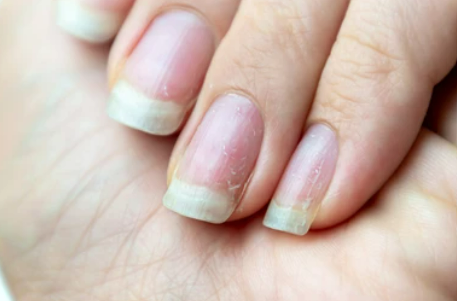
What causes brittle nails?
Brittle nails are a common issue in many people. The problem is that there are quite a few causes of brittle and weak nails. Ironically, two of these being, dehydration and frequent exposure to water. If the fingernails are lacking in any moisture, this dryness leads to peeling and breakage of the keratin layers. On the other hand over exposure to water - especially water with chemicals eg. swimming pools, washing dishes - repeatedly softens, expands then dries keratin layers and the harsh chemicals damage the nail plate.
Another cause of brittle nails can be overuse of nail products. Nail polish contains chemicals that lead to nail discoloration after repeated use. Not to mention that you use acetone as a nail polish remover which is a harsh chemical that dehydrates and irritate the nail and surrounding skin. Consistently applying fake nails is detrimental to nail health as it physically strips away and damages keratin layers in the nail. Not to mention the damage caused by physically filing or drilling down the nail plate. UV light used to set fake nails also has a damaging effect on surrounding skin. When UV light contacts the skin it causes free radicals to occur. These are dangerous and have been linked to conditions such as inflammation and skin cancer.
Hormonal changes can also cause changes in your fingernails. Any woman will know the dramatic effects of fluctuating hormones and what a powerful influence these chemicals have on so many areas of the body. Androgens, estrogens and progesterone and thyroid hormones are key players in producing Keratin in the body.
Expression of keratin proteins, is uniquely regulated by the nuclear receptors for retenoic acid RAR) and thyroid hormone (1)
So the thyroid hormone helps the expression of keratin proteins while androgens, estrogens and progesterone lead to the production of new keratin cells.
keratinocyte = the main cells that make up the primary layer of skin and produce keratin
keratinocyte proliferation = the multiplication of new keratinocyte cells
The binding of androgens to androgen receptors... stimulate the proliferation of keratinocytes.
The binding of estrogens to estrogen receptors regulates cutaneous pigmentation, aging, inflammation, proliferation.
The binding of progesterone to progesterone receptors exert anti-inflammatory and immunosuppressive activities in the skin... and promot(e) keratinocyte proliferation. (2)
Many women notice a change in the condition of their nails when going through pregnancy or menopause due to the fluctuation in hormones.
Understanding the impact hormones can help us see how health issues such as thyroid disorders impact nail health. There are a number of underlying health disorders that can lead to brittle nails. Including but not limited to Anemia, Diabetes or Psoriasis. This is why it is always important to consult your doctor if you are concerned about your health impacting your nail conditions.
_________________
While it is not as commonly attributed to brittle nails, injury or trauma to the nail matrix can cause deformities, ridges or splits in the fingernail. The nail matrix is located behind the cuticle under the skin and is where new nail cells are grown. If it is damaged, the cells it produces can then in turn also be damaged or deformed.
As your body ages it has reduced collagen production and blood flow to the fingernails. Both are symptoms that causes brittle nails. Nutritional deficiencies are also a known cause however these can happen at any age.
Which vitamin deficiency causes brittle nails?
There are many different nutrients that your body needs in order to grow healthy nails. These include:
- Biotin (vitamin B7) - helps promote keratin production
- Iron - Essential component of blood cells that carry oxygen to your nail
- Zinc - important for cell growth
A lack of these specific nutrients are all linked to the development of weak and brittle nails.
How to care for brittle nails
To care for brittle and weak nails it is important to invest in quality products and remedies.
- Use a fine grit nail file such as a glass nail file that is gentle causes less trauma to the nail than an emery board
- Maintain a balanced diet full of essential nutrients
- Utilise nail serums and cuticle oils to help topically treat the nails
- Avoid excess exposure to water and chemicals
- Take a break from fake nails if that is something you regularly use
- Address underlying health issues if you suspect your nail damage may be due to something more complex
(1) Novel Regulation of Keratin Gene Expression by Thyroid Hormone and Retinoid Receptors - Marjana Tomic-Canic,, Doris Day, Herbert H. Samuels, Irwin M. Freedberg, Miroslav Blumenberg
(2) Unraveling the Role of Sex Hormones on Keratinocyte Functions in Human Inflammatory Skin Diseases - Rossella Gratton, Cecilia Del Vecchio, Luisa Zupin, Sergio Crovella





